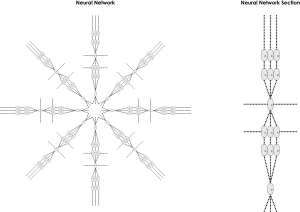
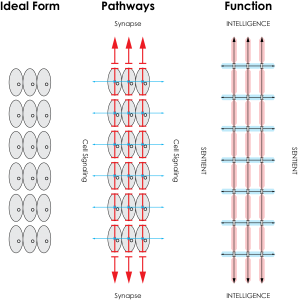

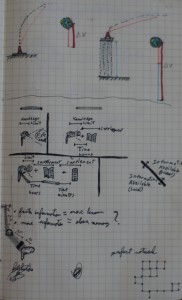

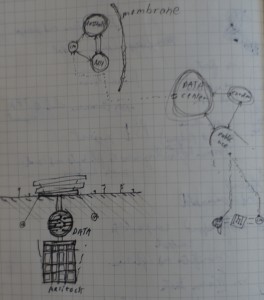
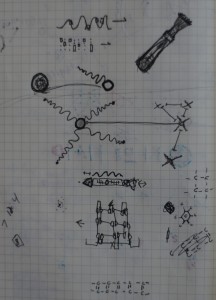
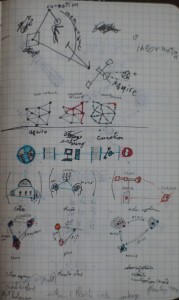
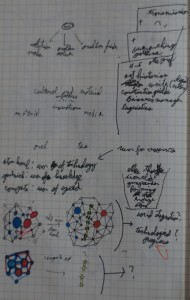
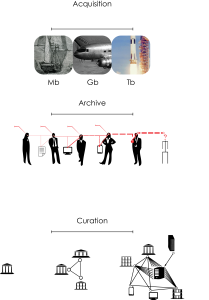
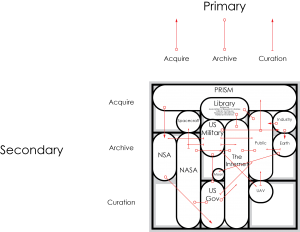
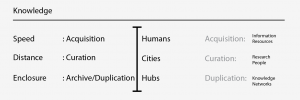
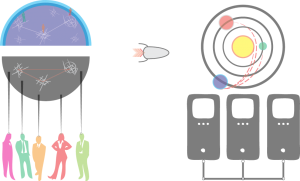
My focus so far has been on the ideas of how enclosures of different scales came into existence. From the earliest moments in life, enclosure became a main focus. The first self replicators adapted to cell membranes because some self replicators produced toxic oxygen that killed any replicator that couldn’t protect itself. Likewise, “Sparta didn’t need walls, the other cities…needed walls to protect themselves from Sparta.”(1) But many of these enclosures dealt with different things that they were trying to protect, or indeed, essentially to archive themselves. For cells it was the genetic information that told the proteins what to create. For cities it was the citizenry which told the city how to operate. From this archiving, duplication was possible. be it the duplication of cells through mitosis, or the duplication of cities through colonization for the Greeks. And, projecting a bit ahead, it can be thought that the Greek city states eventually birthed a multicellular organisms with organs from each type of cell. While Athens focused on mercantilism, Sparta militarism, Corinth colonialism, and Macedon Religion, it can be thought that Rome was the natural evolution of all these into a single organism. And natural selection chose it over the Classical Greeks.. This leads to speculation on what sort of macro species may develop out of the research into the three specific species themselves.
For ourselves, we stand at the cusp of natural selection’s forces. Our information is duplicating like never before, but the need for enclosure is becoming all too apparent. Be it a terrorist seeking to shut down the information flow that keeps the stock market going, or a “script kiddie” trying to shut down his friend’s life by using Ransomware against his computer.
Regardless of the means, this appears to be a form of acquisition. Billions of years ago some self replicators discovered their lives were much easier if they just stole molecules from packets of self replicators that had already gotten them than it was to work to find more molecules(2). And likewise, when mankind first conglomerating into communities, some communities found it was far easier to just raid others than find resources themselves. This trait of acquisition is yet another main parameter of natural selection. He who can acquire the most, is most likely to survive, or at least in most cases. In some cases this process of acquisition goes unchallenged and all dependencies die off. This, of course, is another parameter of evolution. The ability to curate. The ability to fit into a niche and contribute to a system so that all niches in a network self regulate, and one does not doom all.
My first few diagrams focused on these networks. How do they form? What do they want? How do they thrive? How do they progress?
What these diagrams show is an attempt to understand multiple scales and their connections, along with the structures that develop within them. For instance, networks develop gaps, such as in our synapses, which briefly translate information into a different medium. In our scale, similar tasks are already done at government facilities to curate internal networks from external ones like the internet. In another instance, networks can spontaneously develop on the national scale due to technology. But political curation can cause these networks to establish a membrane, such as the iron curtain during the Cold War. In yet another example, some folks in the space technology and exploration field have begun discussions of how to launch rockets at higher altitudes. It has been understood that if most of a rocket is wasted just getting a few miles up, and the small part left can acquire data from as far as Pluto and beyond, then why not just find a way to launch a rocket hole from the outer atmosphere and go even further and faster? These lessons begin to point towards relationships between acquisition, curation, and archiving. Specifically, how information is dealt with and what architectures enclosing them begin to focus on. The following basic diagrams were done in an attempt to see such events at our own visible scales of nations, cities, and people:
Along the way I began looking at theories of one of the best networks we know of. Our brains. I became interested in the theories of Stuart Hameroff(3). Regardless of if he is correct on consciousness, the general mechanisms he spoke about seem to be true, that being the duality of neurons; a network between them through neurological networks, and a network under them for cell signalling, a very real concept. In the basic sense, it allows for the conceptualization of a person in geometric axis.
For example, given an example Neurological network:
I can set such a structure into an ideal network, where all nodes are equal in distance to ensure equal speed of data sharing. This results in an interesting relationship between macro and micro networks:
It becomes apparent that the network has directional relationships that create different results depending on direction of a data packet. If a neuron sends a data packet upstream via electrical signaling, it can share that data locally with its neighbors to work with via chemical signaling, whatever that work may be dedicated to. The electrical pathways enable quick duplication and acquisition of data across long distances, but the chemical signaling can be slower and more secure locally, as it is harder to alter the identity of molecules than it is an electrical signal. This means that the sharing of data locally can be direct, but the sharing of data globally can be duplicated, compared, and isolated if something is rejected. In theory, personhood becomes the relationship between these networks at different scales and directions.
The realization of a duality within networks begins to become apparent as well at multiple scales Molecules transfer long term information via photons and particles. But they transfer short term information at a smaller scale, via virtual particles. Humans transfer information in long term scale via writing and other mechanisms, but they transfer short term scale information via speech. At the city scale, cities transfer long term information via people and materials. But they transfer information short term via the internet (although this may become the opposite in due time.) So from this I can further look into acquisition, curation, and archiving and what sort of dualities in the form of a species they support. The rough equation I’ve formatted to this question is:
Acquisition is a focus on speed, as an infinite distance available in the universe. So, speed becomes a primary focus. Curation becomes a matter of distance, as theoretically all information can be worked with at the speed of light, thus how far the information is becomes the only limiter. Archiving becomes a matter of enclosure. The better the enclosure, the better the ability to archive, and indeed, duplicate the data across multiple nodes for curation. Speed inherently deals with the movement of resources and information along similar networks. Distances can usually be looked in terms of, people as well as application and distribution of that knowledge, And enclosure heavily affects that knowledge and the networks which allow its distribution.
(1) Guaporense, http://historum.com/ancient-history/24362-cities-ancient-greece.html
(2)http://www.ruf.rice.edu/~bioslabs/studies/mitochondria/mitorigin.html
(3) http://www.youtube.com/watch?v=R5DqX9vDcOM